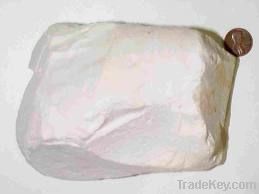Kaolin
- Payment Type: T/T, L/C
Product Description
- Type: Lump
- Whiteness: 90+
In its natural state kaolin is a white, soft powder consisting principally of the mineralkaolinite, which, under the electron microscope, is seen to consist of roughly hexagonal, platy crystals ranging in size from about 0.1 micrometre to 10 micrometres or even larger. These crystals may take vermicular and booklike forms, and occasionally macroscopic forms approaching millimetre size are found. Kaolin as found in nature usually contains varying amounts of other minerals such as muscovite, quartz, feldspar, and anatase. In addition, crude kaolin is frequently stained yellow by iron hydroxide pigments. It is often necessary to bleach the clay chemically to remove the iron pigment and to wash it with water to remove the other minerals in order to prepare kaolin for commercial use.
When kaolin is mixed with water in the range of 20 to 35 percent, it becomes plastic (i.e., it can be molded under pressure), and the shape is retained after the pressure is removed. With larger percentages of water, the kaolin forms a slurry, or watery suspension. The amount of water required to achieve plasticity and viscosity varies with the size of thekaolinite particles and also with certain chemicals that may be present in the kaolin. Kaolin has been mined in France, England, Saxony (Germany), Bohemia (Czech Republic), and in the United States, where the best-known deposits are in the southeastern states.
Approximately 40 percent of the kaolin produced is used in the filling and coating of paper. In filling, the kaolin is mixed with the cellulose fibre and forms an integral part of the paper sheet to give it body, colour, opacity, and printability. In coating, the kaolin is plated along with an adhesive on the paper’s surface to give gloss, colour, high opacity, and greater printability. Kaolin used for coating is prepared so that most of the kaolinite particles are less than two micrometres in diameter.
Kaolin is used extensively in the ceramic industry, where its high fusion temperature and white burning characteristics makes it particularly suitable for the manufacture ofwhiteware (china), porcelain, and refractories. The absence of any iron, alkalies, or alkaline earths in the molecular structure of kaolinite confers upon it these desirable ceramic properties. In the manufacture of whiteware the kaolin is usually mixed with approximately equal amounts of silica and feldspar and a somewhat smaller amount of a plastic light-burning clay known as ball clay. These components are necessary to obtain the proper properties of plasticity, shrinkage, vitrification, etc., for forming and firing the ware. Kaolin is generally used alone in the manufacture of refractories.
Company Profile
- Spectrum Minerals And Trading
- [ Pakistan ]
- This company is registered as a free member and is not verified or authenticated by Tradekey.com
-
Company works in metallic and non metallic minerals.
Metallic minerals like Antimony, lead, Iron in ores.
Non metallic minerals like Dolomite, talcum(soapstone), limestone, Bentonite, basalt, gypsum, selenite etc............
Benefication of minerals like Baso4, Caso4 and mica is our prime projects.
Basic Information
- Company Products / Services: metallic minerals like antimony, lead in ores. non metallic minerals like dolomite, talcum(soapstone), limestone, bentonite.
- Year Established: 2001
- Number of Employees: 6-10
- Website: www.rsunintl.com


